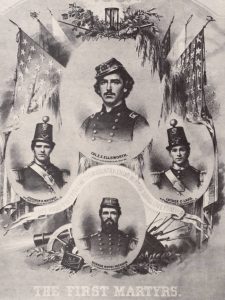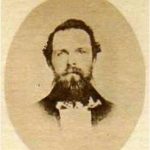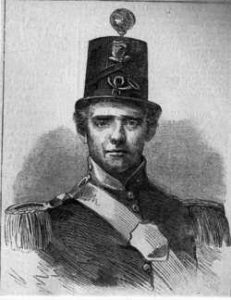Avenging Baltimore’s Patriotic Gore
 When I introduce Colonel Elmer Ellsworth, who died 157 years ago today, as the “first Union casualty” of the Civil War, I get a twinge of conscience. He was not the first battle casualty. Four soldiers who lost their lives changing trains in downtown Baltimore were the first. Their names are Corporal Sumner Henry Needham, Private Luther C. Ladd, Private Addison Whitney, and Private Charles Taylor. Say their names.
When I introduce Colonel Elmer Ellsworth, who died 157 years ago today, as the “first Union casualty” of the Civil War, I get a twinge of conscience. He was not the first battle casualty. Four soldiers who lost their lives changing trains in downtown Baltimore were the first. Their names are Corporal Sumner Henry Needham, Private Luther C. Ladd, Private Addison Whitney, and Private Charles Taylor. Say their names.
Baltimore had never been particularly welcoming to Unionists, including the President-elect. Maryland contained several large secessionist enclaves. It had been the site of a contentious Democratic convention that finally chose Stephen Douglas as the Democratic presidential candidate (although no vice-presidential candidate was decided upon), but these groups remained a minority.[1]Baltimore itself was home to the country’s largest population of free people of color, numbering about 25,000 and many Baltimoreans were supporters of the Union cause. There were regular clashes between pro-and anti-South as well as clashes concerning slavery and secession.[2]
Add to this an odd ordinance concerning the railroad in the city confines. Apparently, no steam rail line was allowed to be constructed through the city, so in order to switch trains at the President Street Station on the east side of town, passengers had to travel the one-mile journey to the Camden Street Station on the west side in horse-drawn rail cars. This had already proved an issue in February 1861, when Lincoln was to go through Baltimore on his way to Washington. Little had changed. On April 18, 1861, Baltimore Mayor George W. Brown, a southern sympathizer, sent a strong letter of warning to President Lincoln:
The people are exasperated to the highest degree by the passage of troops, and the citizens are universally decided in the opinion that no more should be ordered to come. The authorities…did their best to day [sic] to protect both strangers and citizens and to prevent a collision, but [in] vain….it is my solemn duty to inform you that it is not possible for more soldiers to pass through Baltimore unless they fight their way at every step.[3]
To which Secretary of War Simon Cameron replied:
The President is informed that threats are made and measures taken by unlawful combinations of misguided citizens of Maryland to prevent by force the transit of U.S. troops across Maryland on their way pursuant to orders to the defense of this capital.[4]
Volunteers initially arrived from the northeast, responding to Lincoln’s call for a 75,000-man militia to serve for three months issued on April 15, 1961. Massachusetts was one of the first states to send men to the capital, but to get there, they had to travel through Baltimore. On April 17 the 6th Massachusetts Militia left Boston. They traveled through New York and Philadelphia among cheering crowds, and by April 19 were headed toward Baltimore. The Massachusetts men were aware of the city ordinance and already anticipated some slowing in their trip to Washington. They were aware that their rail cars would have to be pulled by horses along Pratt Street to the other side of the city.[5]However, sometime between leaving Philadelphia and arriving in Baltimore, the 6th’s colonel, Edward F. Jones, received information concerning the probability of resistance during the Baltimore transfer. According to his later report Col. Jones gave the following order to each car of volunteers:
The regiment will march through Baltimore in column of sections, arms at will. You will undoubtedly be insulted, abused, and, perhaps, assaulted, to which you must pay no attention whatever, but march with your faces to the front, and pay no attention to the mob, even if they throw stones, bricks, or other missiles; but if you are fired upon and any one of you is hit, your officers will order you to fire. Do not fire into any promiscuous crowds, but select, any man whom you may see aiming at you, and be sure you drop him.[6]
As the militia transfers were taking place, a large mob of plug-uglies*, anti-war supporters, and Confederate sympathizers blocked Pratt Street and attacked the train cars. When it was obvious that the transfer of men could no longer continue as planned, four companies (about 240 soldiers) exited their cars and, marching in formation, attempted to continue through the city. The mob followed the soldiers, causing damage to storefronts and attempting to block the Massachusetts men from reaching their destination. The rear companies of the 6th were attacked with “bricks, paving stones, and pistols.”[7]In response, and under orders, several soldiers fired into the crowd, beginning a giant street brawl referred to by Harper’s Weekly as “The Battle of Baltimore” that involved the 6th Massachusetts, the Baltimore police, and angry Baltimoreans.[8]

By the time the soldiers got to Camden Station, the police had been able to block the crowd. This was not, however, in time to prevent several fatalities. Four soldiers and twelve civilians were killed in the riot. The soldiers were Corporal Sumner Henry Needham (Company I) and privates Luther C. Ladd, Addison Whitney, and Charles Taylor, (Company D).

Corporal Sumner Henry Needham is considered to be the first casualty of the war, although civilians in a Union state killed him. He was thirty-three at the time of his death, and according to a Massachusetts history blog, he died from head wounds inflicted by a blow from a paving stone.[9]He died eight days later, on April 27. He was born in Bethel, Maine but resided in the city of Lawrence, Massachusetts for twelve years before he was inducted into the 6th Regiment of the Massachusetts Volunteer Infantry. At the time of his death, he was a corporal in Company I, having been a member for five years. On May 3 his body was brought back to Lawrence. He lay in state in the City Hall, where thousands of mourners passed by his coffin. The funeral ceremony was conducted by local clergy, and Needham was interred in what would become Bellevue Cemetery under a granite monument inscribed:
By the City Government of Lawrence this monument is erected, to endear t0 posterity the memory of Sumner H. Needham, of company I, Sixth Regiment, M.V.M., who fell a victim to the passions of a Secession mob, during the passage of the regiment through the streets of Baltimore, marching to the defense of the nation’s capital, on the memorable day of 19th of April, A.D., 1861. Aged 33. A loyal North, in common with his widow and only child, mourn his loss.[10]

Private Luther Crawford Ladd was only seventeen years old when he was killed. He is considered to be the first to fall, although there are some who disagree. His injuries included a fractured skull and a fatal bullet wound that severed an artery in his thigh. He was born in Bristol, New Hampshire and was the son of John Ladd. He lived with his family on their farm south of Fowler’s River until 1853, when young Luther and his father moved to nearby Alexandria, New Hampshire so that Luther could attend a public school. In 1860, at age sixteen, Ladd left Alexandria for Lowell, Massachusetts where he obtained employment at the Lowell Machine Shop. He worked there until April 1861, when he answered President Lincoln’s first call for 75,000 men by enlisting for three months in Co. D (The Lowell Guards) of the 6th Massachusetts Militia. His remains were returned to Alexandria, New Hampshire and interred in the Alexandria Village Cemetery. He was later disinterred and reburied beneath the Ladd and Whitney Monument in Lowell, Massachusetts.[11]

Private Addison O. Whitney, a friend of Ladd’s, was also a mill worker at the Lowell Machine Shop. He is also a candidate for being the first death among the four men. Ladd was taken to a nearby infirmary where he bled to death from his wounds, but Whitney was shot in the chest, expiring almost immediately. Lowell, Massachusetts’s historian Richard Howe, Jr. cites evidence of this when he claims that the final-breath quote, “All hail the stars and stripes,” was uttered by Ladd, indicating that Whitney was already deceased.[12]
The remains of Ladd, Whitney, and Needham reached Boston on May 1, 1861. They arrived by train and the “relics of our brave and patriotic soldiers,” were met by Massachusetts Governor John Andrew. At this time, other than Needham, they had not been definitively identified. The bodies were then taken in flag-bedecked hearses to King’s Chapel Church at the corner of Tremont and School streets, where friends and relatives were finally able to positively identify both Ladd and Whitney. A funeral was held in Lowell for the two men, and Whitney was buried in Lowell Cemetery the next day.
That leaves Private Charles A. Taylor . . . about whom little is known. He joined Company D in Lowell the morning it left for Washington. He had still not been issued a uniform by the time his unit reached Baltimore and there is some mystery as to the actual whereabouts of his remains. Some believe that he was mistaken for a civilian and buried in an unmarked grave as no friends or family ever came forth to claim his body. Even newspaper articles pleading for information turned up nothing. There the story stopped until June 17, 1865. On this date, a large obelisk, the Ladd and Whitney Monument, was dedicated. Ladd’s remains were sent from Alexandria to Lowell to join his friend Whitney’s, and both were reburied in Monument Square in downtown Lowell. In a news article written for the Civil War Sesquicentennial about the deaths of these men, writer David Pevear interviewed Lowell Historical Society Martha Mayo concerning Charles Taylor, whose name was added to the monument around 1908. There is no conclusive trail leading to Taylor’s remains, but Librarian Mayo feels, “I don’t think they would have added the name unless they found something . . . a belt buckle, some bones, something.”[13]Taylor’s plaque on the Ladd and Whitney Monument states that he was among “The First To Fall In Defence (sic) Of The Union.”

It seems like a mere drop of blood–four men–hardly enough to fill Leroy Pope Walker’s handkerchief, but they were the beginning of what would become a deluge. Nevertheless, they were the first.
Say their names.
______________________
* Baltimore-ese for men who were seen as ferocious street fighters. There is more to it than just that, but it can wait for another post.
[1]Congressional Quarterly’s Guide to U.S. Elections. Washington, DC: Congressional Quarterly, Inc. 1985. pp. 45–46, 169.
[2]Harry Ezratty, Baltimore in the Civil War: The Pratt Street Riot and a City Occupied, Charleston, SC: The History Press, 2010, 31.
[3]OR, Series 2 – Volume 1. Washington, DC. Government Printing Office, 1894: 564.
[6]OR, Series 1 – Volume 2. Washington, DC. Government Printing Office, 1880: 7.
[7]Civil War Harper’s Weekly, May 4, 1861, 279. (online version available at http://www.sonofthesouth.net/leefoundation/civil-war/1861/may/battle-of-baltimore.htm).
[9]Queen City Massachusetts, “Needham, Sumner Henry (1828-1861),
[11]David M. Rosen, Child Soldiers: A Reference Handbook, ABC-CLIO, April 23, 2012, 147-148 and Social Security Death Index.
[12]David Pevear, “The first of so many to fall: Lowell soldiers’ death 150 years ago marked start of a nation’s epic struggle,” lowellsun.com, http://www.lowellsun.com/ci_17867658 (accessed May 5, 2018).
As a Marylander, I would recommend reading, “A Southern Star for Maryland, Maryland and the Secession Crises”. The book was written by Lawrence Denton, a Johns Hopkins faculty member, and published about 12 years ago. Had not MD been invaded, she would have left the union as well. The Legislature was clambering for the governor to call them into session but he failed to do so until it was too late. Many of Maryland’s citizens were arrested, sent to prison, even members of Francis Scott Keys family could not escape the tyranny and suspension of Habeas Corpus. Southerners were driven out, locked up, property seized for excercising their democratic, constitutional rights.
I had the pleasure of living in Baltimore in the 90s, in Bolton Hill. I enjoyed my time there immensley. I just ordered your recommended book, and look forward to reading it. And hey–sorry about the Orioles this season . . . 🙁
There is always next yr for the Orioles, lol.
As a Yankees fan, I really got tired of saying, “It’s a building year.” Nowif the pitching could equal the hitting . . . !